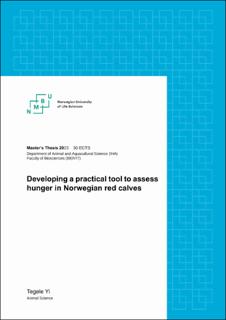| dc.description.abstract | Restrictive feeding practices are commonly employed for dairy calves, but it is imperative to recognize that hunger adversely affects the health and well-being of these young animals. This research aims to develop a practical tool for evaluating hunger in dairy calves. I predicted that the finger sucking test could be used to assess hunger in dairy calves. During the test, I predicted that calves fed restrictive amounts of milk would have a shorter latency to suck on our fingers compared to ad libitum fed calves and before feeding calves will orally manipulate my finger more than after feeding regardless of treatment. Twelve Norwegian Red calves (birth weight: 37.0 ± 3.8 kg) were used in a larger experiment from birth to 12 weeks of age. The specific experiment involving these calves was initiated at approximately 3 weeks of age (24 ± 4 days). Calves were enrolled in 2 treatments, where six calves housed in enriched group (4 females, 2 males) provided ad libitum 4 times per day and six calves housed individually (4 females, 2 males) were fed 7L of milk divided into 3 times per day. Behavioral distinctions were observed between the Enriched and Minimal treatment groups. Calves in the Enriched treatment exhibited more individual variation before feeding compared to minimal group calves, ranging from 0 to 50%. The median sucking percentage to suck finger for enriched group calves were 27.5%. In contrast, calves in the Minimal group displayed a narrower range of sucking behavior, with observations ranging from 0 to 25% and a median of 3.12%. In addition, among the 12 observed calves, a total of 8 calves displayed finger-sucking behavior before feeding, with 5 calves in the enriched group and 3 calves in the minimal group. The findings suggest that group housing may be associated with heightened finger-sucking motivation, in contrast to individually housed calves, potentially contributing to reduced finger sucking behavior. It's important to note that several management differences existed between the groups, and while a 'restricted' milk allowance appeared to have a limited impact on finger-sucking behavior, it is acknowledged that other factors could have influenced these outcomes. | |
